Colony Berlin
|
|
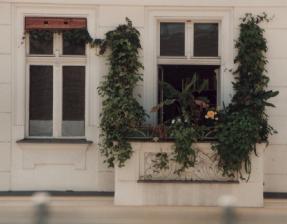
The nest (hole on the left) is
placed in a window on the
4th floor. The nest on the right was never occupied.
On
June 18th 1990 a pair of Swifts occupied a wooden nest box in the center of
Berlin (Neukölln) and from the following year they have bred there
continually. There is a colony of about 15 Common Swifts around this breeding
pair. At first the pair in the box was
the
only breeding pair in the colony, but later on other pairs established
themselves there too.
One
adult was marked with a ring from the German ornithological station Radolfzell
with the number S 48406. It was identified as a male. It did not came back in
1999, when its place was taken by another male. The female probably changed in
1997.
Together
with its females the first male bred 17 chicks and raised 15 of them
successfully. Two died in the rainy year of 1996 from lack of food.
In
the year 1993 was a late brood and I recorded the last daily entry of both
adults into the nest closely. Click here on Table 1 to find the collected data.
Table 2 shows the dates of egg-laying and fledging.
Phenological and breeding dates of
Common Swifts Apus apus at three nest boxes in Berlin-Neukölln
(52,52 N 13,38 E), Germany © Ulrich Tigges
Dates in parentheses have not been
verified, *occupation
|
Year
|
First Swift seen in Berlin
|
Box No.
|
Arrival of
1st adult on nest
|
2nd bird on nest
|
First egg
|
First egg laid after n days after the
arrival of 2nd bird
|
Start of
incubation
|
Hatching of 1st chick
|
Departure of 1st chick
|
Departure of last adult
|
Actual duration of adults’ stay on nest
(first and last day counted)
|
Actual duration of brooding until 1st
chick hatched (hatch day not counted)
|
Actual duration of 1st chick stay in nest
(hatch = day 1,
departure day not counted)
|
Remarks
|
|
1990
|
|
DK1
|
*18.06.
|
*18.06.
|
|
|
|
|
|
04.08.
|
|
|
|
|
|
1991
|
02.05.
|
DK1
|
|
|
|
|
|
|
15.08.
|
15.08.
|
|
|
|
|
|
1992
|
|
DK1
|
|
|
|
|
|
(17.06.)
|
23.07.
|
|
|
|
|
Desertion of nest after ringing
|
|
1993
|
07.05.
|
DK1
|
12.05.
|
|
10.06. (08.07.)
|
|
(10.07.)
|
(29.07.)
|
(07.09.)
|
(07.09.)
|
(119)
|
19
|
40
|
Starlings displace Swifts
|
|
1994
|
29.04.
|
DK1
|
08.05.
|
|
28.05.
|
|
15.06.
|
(05.07.)
|
16.08.
|
20.08.
|
105
|
(20)
|
(42)
|
16.08. both chicks left the nest
|
|
1995
|
01.05.
|
DK1
|
05.05.
|
|
26.05.
|
|
30.05.
|
17.06.
|
27.07.
|
06.08.
|
94
|
18
|
40
|
|
|
1996
|
28.04.
|
DK1
|
08.05.
|
|
27.05.
|
|
30.05.
|
17.06.
|
|
|
|
18
|
|
2 Chicks died: cause bad weather
|
|
1997
|
04.05.
|
DK1
|
16.05.
|
|
03.06.
|
|
05.06.
|
24.06.
|
03.08.
|
07.08.
|
84
|
19
|
40
|
Ein Ad. ab 10.Juli allein
|
|
1998
|
08.05.
|
DK1
|
09.05.
|
|
18.05.
|
|
23.05.
|
(12.06.)
|
22.07.
|
10.08.
|
94
|
(20)
|
(40)
|
|
|
1999
|
07.05.
|
DK1
|
09.05.
|
|
22.05.
|
|
26.05.
|
27.06.
|
05.08.
|
18.08.
|
102
|
32
|
39
|
|
|
2000
|
02.05.
|
DK1
|
08.05.
|
|
01.06.
|
|
03.06.
|
21.06.
|
07.08.
|
11.08.
|
96
|
18
|
47
|
|
|
2001
|
27.04.
|
DK1
|
27.04.
|
|
18.05.
|
|
21.05.
|
07.06.
|
18.07.
|
10.08.
|
106
|
17
|
41
|
|
|
2002
|
01.05.
|
DK1
|
02.05.
|
02.05.
|
(17.05.)
|
|
23.05.
|
|
23.07.
|
30.07.
|
90
|
|
|
no entry 04.-10.05.
|
|
2003
|
28.04.
|
DK1
|
30.04.
|
02.05.
|
12.05.
|
|
16.05.
|
03.06.
|
15.07.
|
05.08.
|
98
|
18
|
42
|
|
|
2004
|
27.04.
|
DK1
|
17.05.
|
20.05.
|
09.06.
|
|
|
27.06.
|
08.08.
|
11.08.
|
87
|
|
42
|
Box moved to new site
|
|
2005
|
29.04.
|
DK1
|
14.05.
|
|
29.05.
|
|
04.06.
|
25.06.
|
07.08.
|
16.08.
|
95
|
21
|
43
|
Nest destroyed by starlings
|
|
2006
|
03.05.
|
DK1
|
03.05.
|
|
(12.05.)
|
|
15.05.
|
03.06.
|
12.07.
|
31.07.
|
90
|
19
|
39
|
|
|
2006
|
|
KK5
|
*10.06.
|
|
|
|
|
15.07.
|
24.08.
|
28.08.
|
(80)
|
|
40
|
new occupation, date not counted
|
|
2007
|
27.04.
|
DK1
|
28.04.
|
|
18.05.
|
|
20.05.
|
07.06.
|
14.07.
|
04.08.
|
99
|
18
|
37
|
|
|
2007
|
|
KK5
|
11.05.
|
|
26.05.
|
|
30.05.
|
14.06.
|
|
05.08.
|
88
|
|
|
|
|
2008
|
27.04.
|
DK1
|
28.04.
|
|
(09.05.)
|
|
13.05.
|
30.05.
|
10.07.
|
02.08.
|
97
|
17
|
41
|
|
|
2008
|
|
KK5
|
21.05.
|
|
05.06.
|
|
08.06.
|
26.06.
|
07.08.
|
07.08.
|
79
|
18
|
42
|
|
|
2009
|
25.04.
|
DK1
|
25.04.
|
28.04.
|
11.05.
|
|
16.05.
|
01.06.
|
|
04.08.
|
102
|
16
|
|
03.05. strong fight in DK1
|
|
2009
|
|
KK5
|
04.05.
|
07.05.
|
18.05.
|
|
20.05.
|
09.06.
|
21.07.
|
02.08.
|
91
|
20
|
42
|
|
|
2010
|
25.04.
|
DK1
|
30.04.
|
30.04.
|
26.05.
|
|
28.05.
|
16.06.
|
26.07.
|
01.08.
|
94
|
19
|
40
|
|
|
2010
|
|
KK5
|
01.05.
|
02.05.
|
25.05.
|
|
29.05.
|
17.06.
|
28.07.
|
01.08.
|
93
|
19
|
41
|
|
|
2011
|
02.05.
|
DK1
|
02.05.
|
06.05.
|
13.05.
|
|
17.05.
|
05.06.*
|
(16.07.*)
|
27.07.
|
87
|
19
|
41
|
*3rd chick
|
|
2011
|
|
KK5
|
05.05.
|
08.05.
|
*10.06.
|
|
12.06.
|
30.06.
|
12.08.
|
14.08.
|
102
|
18
|
43
|
04.06. No eggs anymore. *2nd clutch
|
|
2012
|
27.04.
|
DK1
|
27.04.
|
27.04.
|
|
|
|
28.05.
|
08.07.
|
24.07.
|
89
|
|
41
|
|
|
2012
|
|
KK5
|
27.04.
|
05.05.
|
25.05.
|
|
27.05.
|
16.06.
|
26.07.
|
30.07.
|
95
|
20
|
40
|
Kampf am 19.05.
|
|
2013
|
25.04.
|
DK1
|
06.05.
|
07.05.
|
16.05.
|
|
20.05.
|
07.06.
|
20.07.
|
28.07.
|
|
18
|
43
|
|
|
2013
|
|
KK5
|
06.05.
|
10.05.
|
18.05.
|
|
21.05.
|
10.06.
|
21.07.
|
28.07.
|
|
(19)
|
|
|
|
2013
|
|
EK2/4
|
*30.05.
|
07.06.
|
|
|
|
|
|
05.08.
|
|
|
|
new occupation & likely moving from
EK2 to EK4
|
|
2014
|
03.05.
|
DK1
|
03.05.
|
06.05.
|
16.05.
|
|
20.05.
|
06.06.
|
18.07.
|
28.07.
|
87
|
17
|
42
|
|
|
2014
|
|
KK5
|
08.05.
|
09.05.
|
18.05.
|
|
22.05.
|
08.06.
|
20.07.
|
30.07.
|
|
|
|
|
|
2014
|
|
EK4
|
11.05.
|
11.05.
|
|
|
|
|
|
03.08.
|
|
|
|
|
|
2015
|
03.05.
|
DK1
|
03.05.
|
08.05.
|
17.05.
|
|
20.05.
|
07.06.
|
21.07.
|
04.08.
|
94
|
18
|
44
|
|
|
2015
|
|
KK5
|
05.05.
|
09.05.
|
17.05.
|
|
22.05.
|
08.06.
|
22.07.
|
03.08.
|
92
|
17
|
44
|
|
|
2015
|
|
EK4
|
11.05.
|
12.05.
|
|
|
|
|
|
04.08.
|
86
|
|
|
|
|
2016
|
30.04.
|
DK1
|
05.05.
|
07.05.
|
13.05.
|
|
18.05.
|
04.06.
|
16.07.
|
|
|
17
|
42
|
|
|
2016
|
|
KK5
|
30.04.
|
08.05.
|
14.05.
|
|
17.05.
|
|
16.07.
|
|
|
|
|
|
|
2016
|
|
EK2
|
*02.06.
|
*02.06.
|
|
|
|
03.07.
|
|
|
|
|
|
|
|
2016
|
|
EK4
|
01.05.
|
08.05.
|
|
|
|
|
|
|
|
|
|
probably new personel, no breeding
|
|
2016
|
|
KK8
|
*10.06.
|
*10.06.
|
|
|
|
|
|
|
|
|
|
|
|
Median
until 2015
|
29.04.
n=24
|
|
05.05.
n=36
|
07.05. n=19
|
22.05. n=27
|
|
23.05. n=28
|
10.06. n=26
|
22.07. n=32
|
04.08. n=34
|
From median dates 94 n=27, from
actual dates 93 n=27
|
From median dates 18 days, from actual
dates 19 days n=25 (= average value 18,8, n=25)
|
From median dates 41 days, from actual
dates 41 days (= average value 41,4 n=26)
|
Medians, documented data only, without
exceptional data, e.g. dates
of 1st occuptions or late broods, etc.
|
The median of the arrival of the
advance guard” in Berlin is 24.04. That is 14 days before the arrival of
the ”main body” (N=24, see APUSlist 2405). The duration of
the species’ stay in the breeding area is 109 days, the duration of the
species’ stay on the nest is 95 days.
Note: The “median” is in the
middle of a row of specified dates. The difference between the medians
of arrival and departure is the same as the arithmetical medial from the
length of the stays, unlike the dates from the development of the
chicks, where the dates differ by 1.5 days.
For dates from the colony in Skurup, Sweden please
click here.
To see the Common Swift calendar, click
here.
Some
pictures of the colony in Berlin
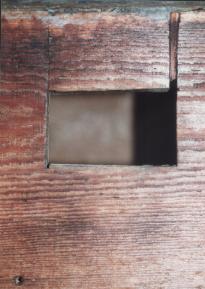
DK1 Entrance hole
This is the entrance hole of the nestbox,
measuring 38 x 64 mm. Below the hole you
can see two dark areas caused by the Swifts’
tail feathers brushing against the nestbox as
they enter it. This helps them reduce speed.
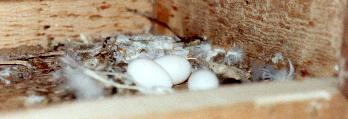
DK1 Three eggs
Swifts in Central Europe mostly lay two or three eggs. The
pairs in this nestbox mostly lay three eggs, but rise only two
chicks. They throw the third egg out of the nest.

Broken egg
Sometimes there are fights in the nestbox and eggs get
broken. Only individuals of the same sex fight each other
and break eggs like this.

DK breeding3
One adult on the nest, hatching. One pink-colored chick can be seen in the
background, below the adult’s wing.
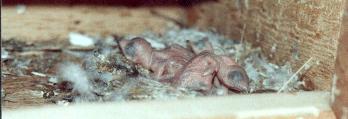
DK1 Three pulli
In 1992 three chicks were raised.
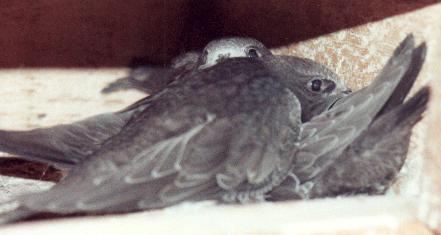
DK1 3 pulli
Before ringing.

DK1 Visit
This is what it looks like when a visiting Swift checks the nestbox. It will fly close to the entrance
hole and sometimes scream before turning back. You can see dark areas from the tail feathers
below the hole very clearly here.
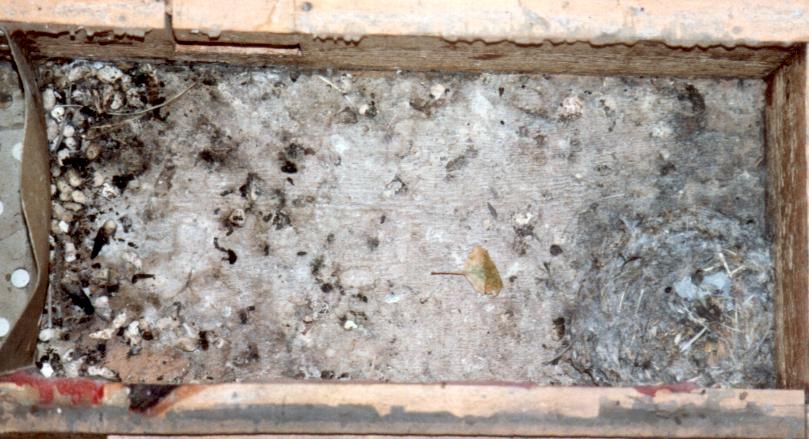
DK1 Interior of nestbox
This is what a nestbox looks from the inside, at the end of one breeding
season. On the right (at the bottom) is the nest. It is as far
from the entrance hole as possible. You can see the entrance hole as the dark
horizontal stripe on the upper left. On the left are
balls of faeces. Towards the end of the season, the parents become a little
careless and don’t remove every faecal ball the chicks produce.
For the
past few years, the colony has also seen a spectacular display by
non-breeders. At dusk or shortly before it, they assemble then
repeatedly build a loudly screaming flock that stays together for 200-300
meters before separating ready to do the same again. As it gets dark, they fly
higher and higher above the same site, eventually disappearing into the
darkness for sleep on the wing.
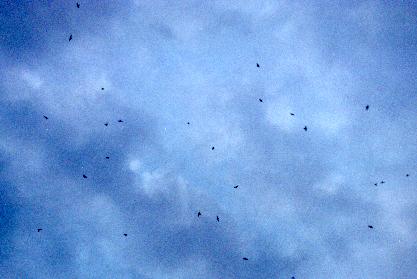
At twilight the non-breeders assemble
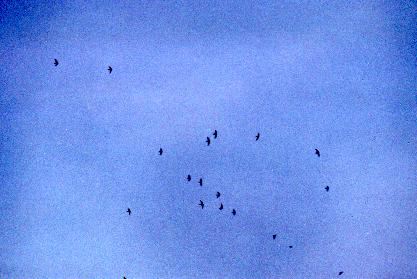
They build flocks and scream

Finally they disappear into the darkness
Papers
written about this colony:
Tigges,
Ulrich (1994): Beobachtungen am Mauersegler (Apus apus) und Bericht über
eine Spätbrut 1993. Berliner ornithologischer Bericht 04:129-141 (APUSlist
No. 0195)
Tigges, Ulrich (1995): Kann man Mauersegler gezielt ansiedeln? Der Falke 42:
250-252 (APUSlist No. 0041)
Tigges, Ulrich (1999): Spatial behaviour of the Common Swift (Apus apus)
APUSlife 0061
Tigges, Ulrich (2000): Territoriumgedrag van Gierzwaluwen (Apus apus)
in de lucht. Apus 07: 3-5 (APUSlist No. 2548) (Dutch version of APUSlife
No. 0061)
Tigges, Ulrich (1999): Das täglich letzte Einfliegen der Mauersegler (Apus
apus) in Abhängigkeit von Brutphänologie, Umwelt- und sozialen Faktoren.
Berliner ornithologischer Bericht 09: 49-58 (APUSlist No. 0067)
(German version of APUSlist No. 2340)
Tigges, Ulrich (1999): On the breeding phenology of the Common Swift (Apus
apus) the last diurnal return to nest with reference to environmental and
social factors. APUSlife 2240 (English version of APUSlist
No. 0067)
Other colonies
|
|
|
[StatCounter.html]
Commonswift
Worldwide ©
Ulrich Tigges
Apus apus, Swifts, Commonswift, gierzwaluw, vencejo comun, sis hachomot,
סיס החומות,
Црна чиопа,
Kara Sağan,
Čiopa, ciopa, chyorny strizh,
Gierzwaluw (Apus apus), Vencejo
común,
Черный
Стриж,
Martinet noir, Rondone comune, rondoni,
åtactara,
السمامة,
Mauersegler, Apuslife
Commonswift's topography, togography of the Commonswift, feathers, crown, eye
line, eye patch, forecrown, lore, chin, throat, ear coverts, hindneck, mantle,
scapulars, rump, uppertail coverts, tail, tertials, greater coverts, secondaries,
median coverts, leading edge coverts, lesser coverts, lesser primary coverts,
alula, median primary coverts, leading edge coverts, greater primary coverts,
primaries, median coverts, greater coverts, secondaries, axillaries, undertail,
undertail coverts, rear flank, vent, flank, belly, brest, apodidae, apodiformes,
size, color, colour, weight, sex, flight acquaintance, flight speed, age, food,
enemies, pair bonding, nest, eggs, egg, young, bad weather, voice, download wave
file, survive, survival, colony, flying insects
|







